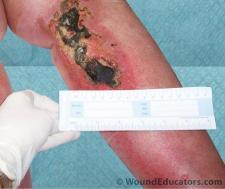Signs of Wound Infection That Everyone Should Know
Wound infection is such a common condition and presents so often that every wound care professional will recognize the major signs and symptoms almost instantly. However, the consequences of diagnosing wound infection late, or missing the signs of wound infection completely, are such that it is worth spending a few moments every now and again to remind ourselves of all the signs of wound infection.
As we are taught during training, the principal signs of wound infection are:
- rubor
- calor
- tumor
- functio laesa
- drainage
- decline in wound status
Rubor in an infected wound describes a poorly defined erythemal border with a disproportionate amount of erythema, while calor describes a magnified localized increase in temperature with warmth extending further away from the site and a possible systemic increase in body temperature. Tumor, another common sign of wound infection, describes excessive edema compared with the size of the wound, with possible induration of tissue around the wound.
An increased and excessive level pain (dolor) is also commonly associated with wound infection, as well as functio laesa which can include malaise, decreased energy, tachycardia, hypotension, altered mental status, and altered function of affected area. The sixth sign of wound infection is a disproportionate amount of drainage, which may be thick, viscous, purulent, or creamy and possibly malodorous. Drainage from an infected wound may also be white, yellow, green, or blue in color. Finally, a decline in wound status, in which an infected wound exhibits a plateau in healing or change in the appearance of the granulation tissue, is another classic sign of wound infection.
As well as infections displaying the classic signs, the wound care professional should also be aware of silent infections such as abscess, and gangrenous toes as well as possible infection in patients with arterial insufficiency. If this type of silent wound infection is suspected, then it is important to look for systemic signs of infection and manage accordingly.
Learn More with Our Wound Care Education Options
Interested in learning more about wound care and certification? Browse through our wound care certification courses for information on our comprehensive range of education options to suit healthcare professionals across the full spectrum of qualifications and experience.
Editors Note: This post was originally published in December 2003 and has been revamped and updated for accuracy and comprehensiveness.


Some employers offer formal apprenticeships.